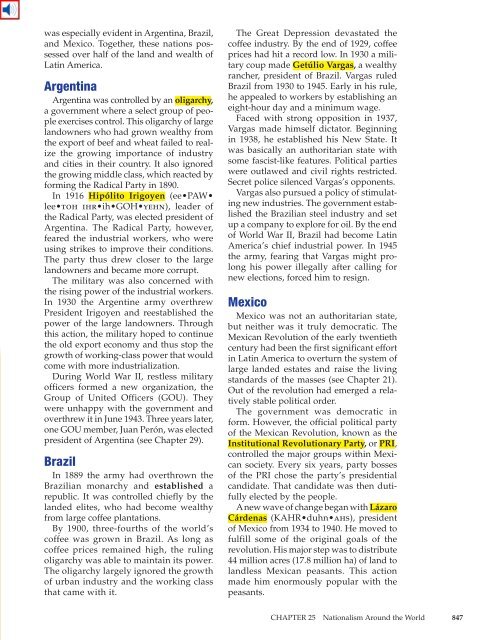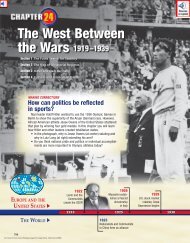Chapter 25 Text - APAblog.org
Chapter 25 Text - APAblog.org
Chapter 25 Text - APAblog.org
You also want an ePaper? Increase the reach of your titles
YUMPU automatically turns print PDFs into web optimized ePapers that Google loves.
was especially evident in Argentina, Brazil,and Mexico. Together, these nations possessedover half of the land and wealth ofLatin America.ArgentinaArgentina was controlled by an oligarchy,a government where a select group of peopleexercises control. This oligarchy of largelandowners who had grown wealthy fromthe export of beef and wheat failed to realizethe growing importance of industryand cities in their country. It also ignoredthe growing middle class, which reacted byforming the Radical Party in 1890.In 1916 Hipólito Irigoyen (ee•PAW•lee•toh ihr•ih•GOH•yehn), leader ofthe Radical Party, was elected president ofArgentina. The Radical Party, however,feared the industrial workers, who wereusing strikes to improve their conditions.The party thus drew closer to the largelandowners and became more corrupt.The military was also concerned withthe rising power of the industrial workers.In 1930 the Argentine army overthrewPresident Irigoyen and reestablished thepower of the large landowners. Throughthis action, the military hoped to continuethe old export economy and thus stop thegrowth of working-class power that wouldcome with more industrialization.During World War II, restless militaryofficers formed a new <strong>org</strong>anization, theGroup of United Officers (GOU). Theywere unhappy with the government andoverthrew it in June 1943. Three years later,one GOU member, Juan Perón, was electedpresident of Argentina (see <strong>Chapter</strong> 29).BrazilIn 1889 the army had overthrown theBrazilian monarchy and established arepublic. It was controlled chiefly by thelanded elites, who had become wealthyfrom large coffee plantations.By 1900, three-fourths of the world’scoffee was grown in Brazil. As long ascoffee prices remained high, the rulingoligarchy was able to maintain its power.The oligarchy largely ignored the growthof urban industry and the working classthat came with it.The Great Depression devastated thecoffee industry. By the end of 1929, coffeeprices had hit a record low. In 1930 a militarycoup made Getúlio Vargas, a wealthyrancher, president of Brazil. Vargas ruledBrazil from 1930 to 1945. Early in his rule,he appealed to workers by establishing aneight-hour day and a minimum wage.Faced with strong opposition in 1937,Vargas made himself dictator. Beginningin 1938, he established his New State. Itwas basically an authoritarian state withsome fascist-like features. Political partieswere outlawed and civil rights restricted.Secret police silenced Vargas’s opponents.Vargas also pursued a policy of stimulatingnew industries. The government establishedthe Brazilian steel industry and setup a company to explore for oil. By the endof World War II, Brazil had become LatinAmerica’s chief industrial power. In 1945the army, fearing that Vargas might prolonghis power illegally after calling fornew elections, forced him to resign.MexicoMexico was not an authoritarian state,but neither was it truly democratic. TheMexican Revolution of the early twentiethcentury had been the first significant effortin Latin America to overturn the system oflarge landed estates and raise the livingstandards of the masses (see <strong>Chapter</strong> 21).Out of the revolution had emerged a relativelystable political order.The government was democratic inform. However, the official political partyof the Mexican Revolution, known as theInstitutional Revolutionary Party, or PRI,controlled the major groups within Mexicansociety. Every six years, party bossesof the PRI chose the party’s presidentialcandidate. That candidate was then dutifullyelected by the people.A new wave of change began with LázaroCárdenas (KAHR•duhn•ahs), presidentof Mexico from 1934 to 1940. He moved tofulfill some of the original goals of therevolution. His major step was to distribute44 million acres (17.8 million ha) of land tolandless Mexican peasants. This actionmade him enormously popular with thepeasants.CHAPTER <strong>25</strong> Nationalism Around the World 847



